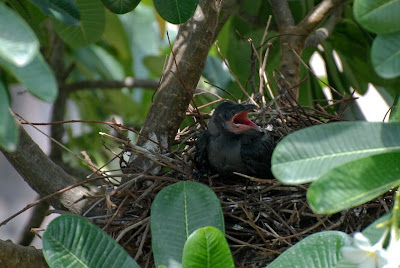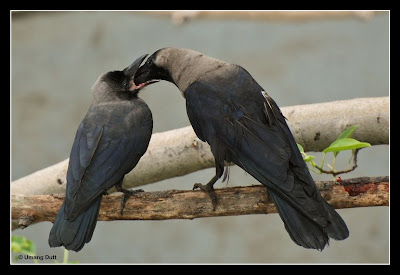The true crows are large passerine birds that comprise the genus Corvus in the family Corvidae. Ranging in size from the relatively small pigeon-sized jackdaws (Eurasian and Daurian) to the Common Raven of the Holarctic region and Thick-billed Raven of the highlands of Ethiopia, the 40 or so members of this genus occur on all temperate continents (except South America) and several offshore and oceanic islands (including Hawaii).
The crow genus makes up a third of the species in the corvid family. Other corvids include rooks and jays. Crows appear to have evolved in Asia from the corvid stock, which had evolved in Australasia. A group of crows is called a "murder."

Crows make a wide variety of calls or vocalizations. Whether the crows' system of communication constitutes a language is a topic of debate and study. Crows have also been observed to respond to calls of other species; this behavior is presumably learned because it varies regionally. Crows' vocalizations are complex and poorly understood. Some of the many vocalizations that crows make are a "caw", usually echoed back and forth between birds, a series of "caws" in discrete units, counting out numbers, a long caw followed by a series of short caws (usually made when a bird takes off from a perch), an echo-like "eh-aw" sound, and more. These vocalizations vary by species, and within each species vary regionally. In many species, the pattern and number of the numerical vocalizations have been observed to change in response to events in the surroundings (i.e. arrival or departure of crows). Crows can hear sound frequencies lower than those that humans can hear, which complicates the study of their vocalizations.
Loud, throaty "caw-aw-ah"'s are usually used to indicate hunger or to mark territory. When defending a nest site or food, crows will usually enlarge their crest feathers and hunch their shoulders to increase their size. Softer, gurgling sounds have also been observed as a sort of beckoning call, or a call of affection. These noises are emitted from within the throat of the bird, much like a cat's purring.


The House Crow (Corvus splendens), also known as the Colombo Crow is a common Asian bird of the Crow family. It is between the Jackdaw and the Carrion Crow in size (40 cm in length) but is relatively slimmer than either. The forehead, crown, throat and upper breast are a richly glossed black, whilst the neck and breast are a lighter grey-brown in colour. The wings, tail and legs are black. There are regional variations in the thickness of the bill and the depth of colour in areas of the plumage.
It has a widespread distribution in southern Asia, being native to India, Pakistan, Sri Lanka, Maldives and Laccadive Islands, South West Thailand and coastal southern Iran. It has been introduced to East Africa around Zanzibar (around 1897) and Port Sudan, and arrived in Australia via ship but has up to now been exterminated. Recently it has made its arrival in Europe, and has been breeding in the Hook of Holland since 1998. It is associated with human settlements in all of its range, from small villages to large cities.
Due to a human population explosion in the areas it inhabits, this species has also proportionately multiplied. Being an omnivorous scavenger has enabled it to thrive in such circumstances.
The invasive potential for the species is great all over the tropics. It has as yet not established in the New World. This species is able to make use of resources with great flexibility and appears to be associated with humans and no populations are known to exist independently of humans



At least some trees in the local environment seem to be necessary for its successful breeding. It lays 3-6 eggs in a typical stick nest, and occasionally there are several nests in the same tree. In South Asia they are parasitized by the Asian Koel.




3 comments:
just simply jealous... ext time u go on such a beautiful holiday... pl invite us also... gr8
Nice timing!!!!
House crow Bird Photos Images Free Download
Post a Comment